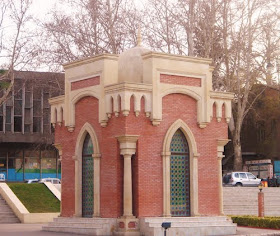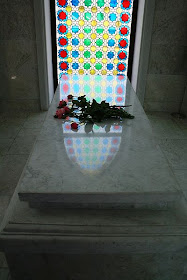The Gates of Ganja, a 11th-century gates from the city of Ganja brought by the Georgians as a war booty to the Gelati Monastery, where it can still be seen near the tomb of King David IV of Georgia
Ganja State University (GDU, Azerbaijani: Gəncə Dövlət Universiteti) is a public university located in Ganja, Azerbaijan.
According to the resolution of the Soviet of People's Commissars of Azerbaijan from April 14, 1938 a two year Pedagogical Institute named after Nadezhda Krupskaya was established in the city of Ganja, Azerbaijan. Due to a lack of available space, the college was placed on the third floor of Gorky School. The first two departments of the institute were Natural Sciences Department and the Department of Physics and Mathematics. Twenty three teachers were hired to teach at the institute. The first class of 244 students started on October 1, 1938. In 1939, two more departments (History and, Azerbaijani language and literature) were established within the institute.
On September 1, 1943 the two-year college was abolished and a four-year Kirovobad (Ganja) State Pedagogical Institute was established on its basis. In fall of 1943, the institute was named after a renown scientist and publicist of Azerbaijan Hasan bey Zardabi.
On June 13, 2000 the President of Azerbaijan renamed the institute to Ganja State University.
Currently, there are 8 faculty departments and 10 offices at the university. It provides Bachelor's, Master's and doctoral degrees.
Azerbaijan State Agricultural Academy (Azerbaijani: Azərbaycan Kənd Təsərrüfat Akademiyası, literally "Azerbaijan Village Agriculture Academy"), also referred to as the Azerbaijan Agricultural Academy (Az. AA), is a public university located in Ganja, Azerbaijan. The university has eight schools, 3830 students and 560 faculty members. In addition, there is a teaching site in Gazakh with nearly 500 correspondent students.
Azerbaijan State Agricultural Academy traces its history to the Baku Polytechnical Institute's Department of Agriculture, which was established on November 14, 1920. Originally located in Baku, the school was original formed in 1920 after the invasion of the Red Army and the establishment of the fledgling Azerbaijan SSR. The new government decreed that the previous technical school, Baku Polytechnicum, would close and be replaced by Baku Polytechnical Institute, a more traditional polytechnic institute. The new school focused on training engineers in a broad range of industries: agriculture, civil engineering, electromechanical, economics and oil. The new school went through many name changes over the years as its emphasis changed to meet the needs of Azerbaijan. In 1923 the school changed its name to Azerbaijan Polytechnical Institute. In March 1929, the Azerbaijan Communist Party decreed that the school be split into three independent schools covering agriculture, economics and oil.
Today the university is the only state school in Azerbaijan that offers a university-level degree for the agricultural sector.
Note: Ex-rector, Mr. Məmmədtağı İbrahim oğlu Cəfərov has recently died. The new rector was appointed on November 21, 2008.
Ganja International Airport (Azerbaijani: Gəncə Beynəlxalq Hava Limanı) (IATA: KVD, ICAO: UBBG) is an airport serving Ganja (also known as Gyandzha), the second-largest city in Azerbaijan.
It is also used by the Azerbaijani Air and Air Defence Force and was previously used by the Soviet Air Force.
The airport resides at an elevation of 1,083 feet (330 m) above mean sea level. It had one runway designated 12/30 with a concrete surface measuring 2,500 by 44 metres (8,202 × 144 ft). This became Runway 12R/30L after the addition of the longer Runway 12L/30R, which measures 3,300 by 44 metres (10,827 × 144 ft).
Javad khan Ziyad oghlu Qajar a member of the royal Qajar family, (1786-1804) the khan of Ganja khanate. He is the last khan of the Ganja Khanate.
During the first Russo-Persian War (1804-1813), Ganja was considered by Russians as a town of foremost importance. General Pavel Tsitsianov approached Javad khan several times asking him to submit to Russian rule, but each time was refused. In November 1803, the Russian army moved from Tiflis and in December, Tsitsianov started the siege preparations. After heavy artillery bombardment, on January 3, 1804, Tsitsianov gave the order to attack the fortress. After fierce fighting the Russians were able to capture the fortress. Javad khan was killed, together with his sons.
His Mousulium is in Ganja City, Azerbaijan.
The Nizami Mausoleum (Azerbaijani: Nizami məqbərəsi), built in honor of the 12th-century poet Nizami Ganjavi, stands just outside the city of Ganja, Azerbaijan. The mausoleum was originally built in 1947 in place of an old collapsed mausoleum, and rebuilt in its present form in 1991.
The tomb of Nizami has been a place of devoted pilgrimage for many centuries. According to historian Vasily Bartold, the mausoleum was first mentioned in historical chronicles in 1606. The Safavid court chronicler Iskander Beg Munshi reported that toward the end of February 1606, Shah Abbas I reached Ganja and camped near the tomb of Sheikh Nizami, where on 24 March he celebrated the holiday of Novruz.
During the Russo-Persian War in 1826 a decisive battle between Russian and Persian forces took place near the tomb of Nizami. The Russian forces under the command of General Ivan Paskevich defeated the Persian army and forced it to retreat. Russian envoy to Persia Aleksandr Griboyedov mentioned in his diary a conversation with writer and historian Abbasgulu Bakikhanov, a member of the Russian diplomatic mission at the time, in which the latter told him that Elisabethpol battle was near the Nizami tomb.
According to Bakikhanov, by the 1840s the tomb of Nizami had collapsed, and former vezir of Karabakh khanate Mirza Adigozal Bey was rebuilding it.
In 1873 Shah of Persia Naser al-Din Qajar, on the way home from his first tour in Europe, passed by the tomb of Nizami. He mentioned in his diary the tomb of Shaykh Nizami by the side of the road at about half a league or more from Ganja, and described it as "a very wretched brick building".
By the turn of the 20th century, the mausoleum became almost completely ruined. In 1925 the grave of the poet was excavated and his remains exhumed for reburial at the center of Ganja. However, the leadership of Soviet Azerbaijan ordered the reburial of the poet at the same location and the erection of a temporary monument.
In 1940, in connection with construction of a new mausoleum, an archaeological investigation revealed the remains of an ancient mausoleum deep under the ground, dating to the 13th century. The remains of an overground structure were a 19th-century restoration.
In 1947 a new mausoleum was constructed from limestone. Later the Soviet government constructed an aluminium production plant in the vicinity of the mausoleum. The hazardous emissions from the plant seriously damaged the building, and it collapsed by the late 1980s.
The mausoleum was rebuilt in its present form after the Azerbaijan Republic regained its independence following the fall of the Soviet Union in 1991.
It is a tall cylindrical building, surrounded by gardens. To one side, there are metal statues commemorating Nizami's epic poems. The mausoleum was constructed from solid granite blocks, delivered from the Ukraine. Farman Imamguliyev was the architect; the statues were created by sculptor Gorkhmaz Sudjaddinov.




































The pictures and the descriptions were educational and great. Thank you very much. Kei Esmaeilpour, MSM
ReplyDelete